Cardiac drift refers to increasing heart rate despite constant intensity over prolonged exercise. What causes it? In a nutshell HR rises in order to maintain cardiac output despite a decline in how *hard* the heart is pumping (aka “stroke volume”). The lower the intensity, and more trained the athlete, then the lower the cardiac drift. Cardiac drift is actually hard to measure accurately and therefore not a very useful metric but it is also much misunderstood, so let’s look into it.
HR Drift is a feature of high Intensity (fixed time)
It seems obvious that HR rises with intensity over a fixed time (eg 10mins). It is so obvious that no one describes this as cardiac drift (because there is no steady-state baseline). The reason HR increases is that cardiac output dramatically rises to meet the energy demands of muscle during exercise (and other tissues including the heart itself).
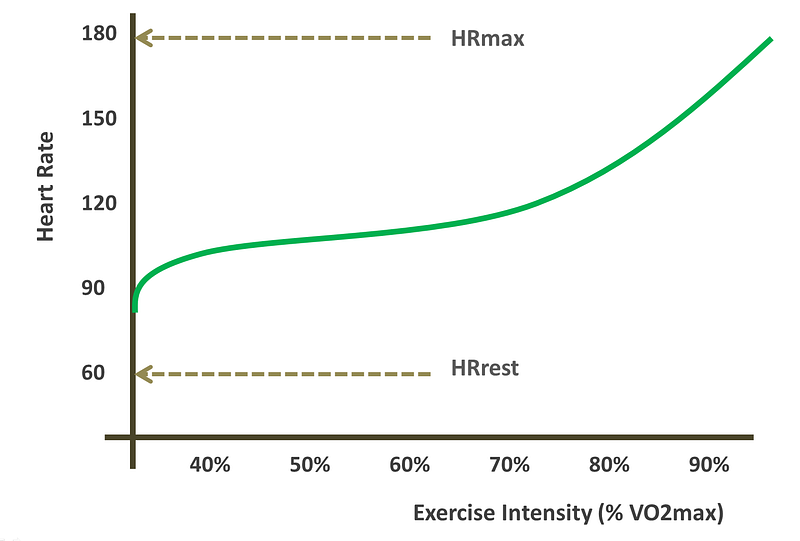
HR Drift Rises with long duration (fixed intensity)
It is a little less obvious (but actually not surprising) that HR rises with exercise duration even over a fixed intensity (eg 70% of VO2max). after all we know energy requirements are tied to power and duration:
energy (kcal) = avg power (Watts) X duration (hours) X 3.6
Why 3.6? This is to adjust for time and the factor of 1000 reduction to get from cal to kcal (60 seconds/minute * 60 minutes/hour * 1/1000 cal/kcal = 3.6).
If we can find a steady state, then we can (rather imprecisely) define cardiac drift. But there is rarely a totally steady-state HR during a tough effort.
Three reasons contribute to rising HR with time: #1 muscles become fatigued (and need more resources to keep going), #2 the brain tells the body to go easy (see central governor theory) and lastly #3 (but the main physiological reason) is that HR rises essentially to compensate for lowered stroke volume as follows:
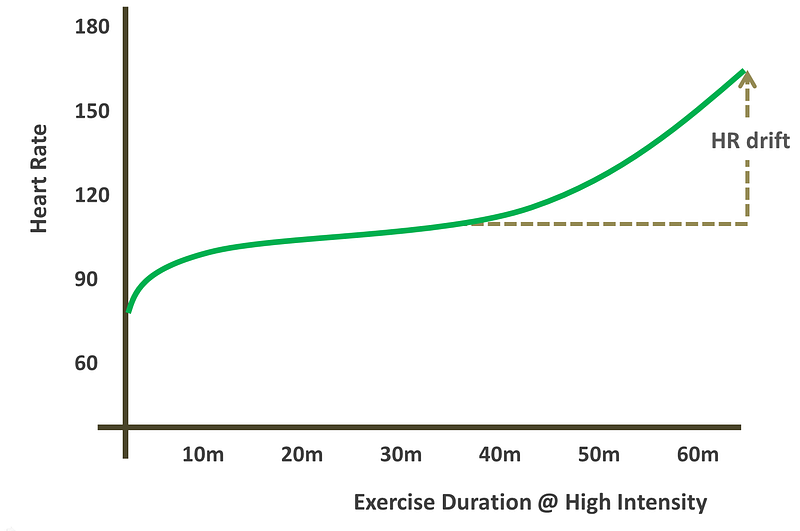
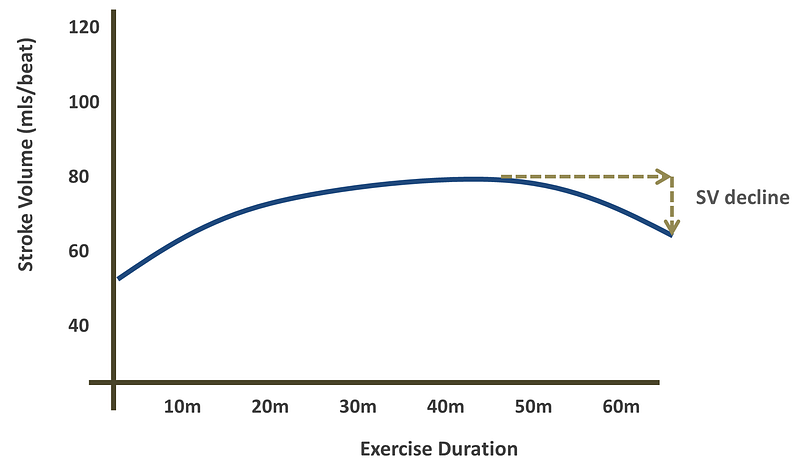
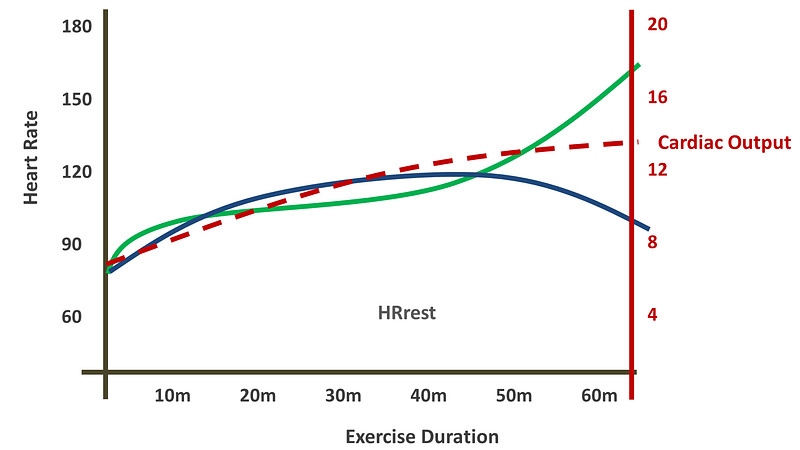
If HR rises in close correlation to the decline in SV then vital cardiac output can be maintained longer, and although it becomes increasingly uncomfortable, you can still escape that chasing bear. (You do remember the function of exercise is fundamentally to escape threat, and to pursue opportunities that help survival right?) 😂

Wait Why Does Stroke Volume Decline?
When the demands of cardiac output are very high, does it seem strange that SV declines? It would be great if it kept rising wouldn’t it?
Well, it would be dangerous because the heart ventricles can only stretch so far. Max cardiac output is around 20-40L/min (untrained vs trained) and at around 50% of this, stroke volume tends to plateau. The main reason why stroke volume declines is that with an increase in heart rate, the diastolic filling time becomes limiting, meaning there is not enough time to fill the chamber of the heart with blood before it has to be ejected.
In medicine this is related to the Frank-Starling law :
the Frank-Starling law : the force or tension developed in a muscle fiber depends on the extent to which the fiber is stretched.
ie Frank-Starling law : the heart ejection contraction depends on the extent of blood filling the chamber
When increased quantities of venous blood flow into the heart (increasing preload), the walls of the heart stretch and therefore the ejection force is high……but this cannot be maintained indefinitely (don’t worry, this is not likely to be an issue in a healthy person unless HR is above 180bpm)
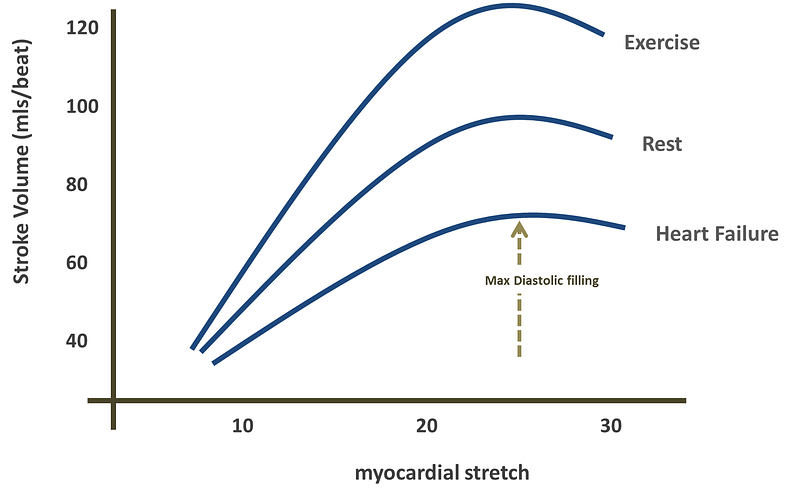
What is the Effect of Training on HR Drift?
As usual, when you train, you improve all aspects of the equation including improved:
longer ventricular ejection times
greater myocardial contractility
greater left ventricular diameter and mass
shorter diastolic filling times
shorter ejection times
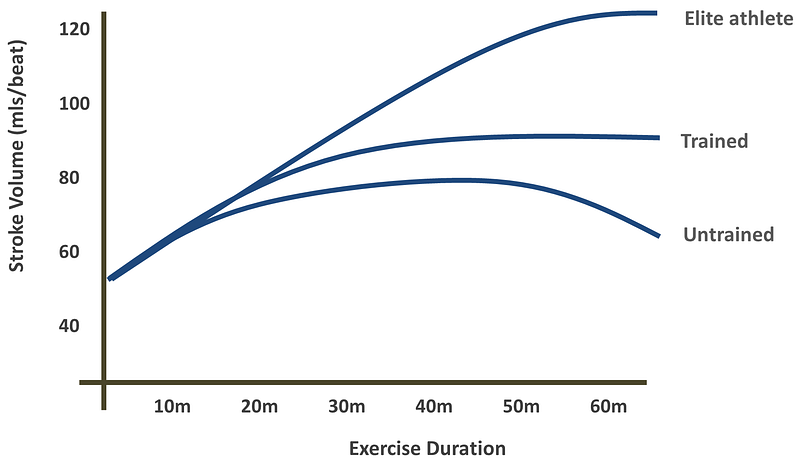
So basically with training….. SV is improved and HR drift is postponed (well until a later, harder point!).
The surprising bit is that in trained athletes, stroke volume can be maintained even at higher heart rates, ie diastolic filling is maintained despite very fast contraction times.

Gledhill (1994) suggested that the higher blood volumes in the trained subjects maintained an adequate ventricular filling pressure during exercise, thereby enhancing diastolic filling. This appears linked with increased plasma fraction in the blood in athletes (blood volume increases with training)/. There is also reduced afterload which enhances diastolic emptying (attributed to lower systolic and diastolic blood pressures in trained subjects)
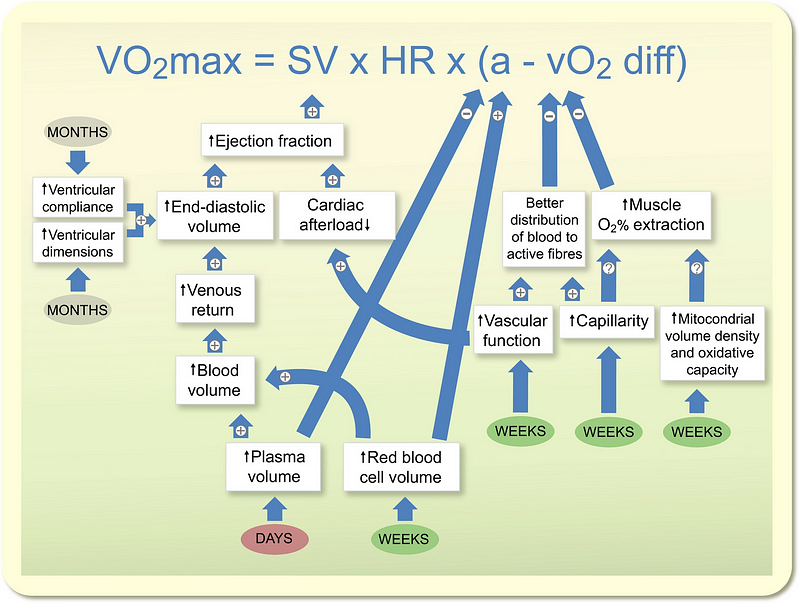
A quick aside, but plasma volume may increase around 10% following a single exercise bout whereas increases in red blood cell volume usually takes 6-12 weeks
Conclusion: Is HR Drift a Helpful Training Concept?
Er not really. Sorry about that. We hardly measure it do we? Thats says a lot in itself. But it is a useful theoretical concept to talk about cardiovascular performance.
But what are the training implications then?
Training implications: Should You Train to a Fixed HR?
If you cap/limit HR to say 90% of HRmax and try and hold it there, then your cardiac output would slowly reduce and hence performance would decline. What you would feel is increasing fatigue and you would have to reduce performance (ie effort aka slow down) in order to balance your self-imposed static HR.
Wingo and Cureton showed that during (submax) cycling for 45 minutes athletes who maintained a steady HR had to reduce power output by 37%. Phil Maffetone showed the same in two runners (link) on a ten mile run trying to maintain a HR of 146, with each one-mile split recorded.
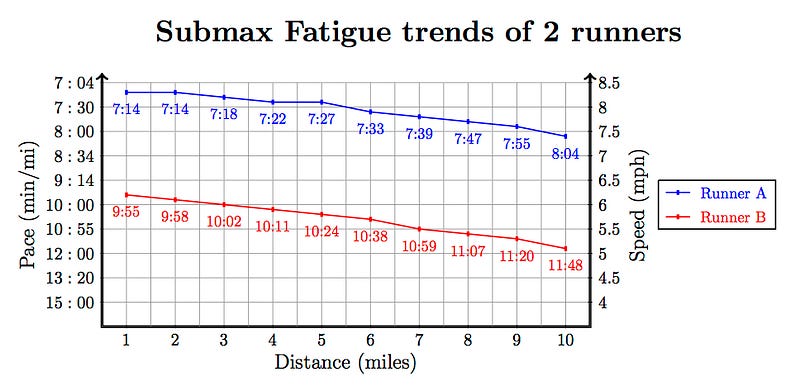
Is this useful? Well this is a good training session where you want to train to easy or moderate effort. It doesn’t work so well at the hardest levels but It is an alternative to zone based recovery training when you don’t have a power meter.
However, training towards high/threshold heart rates becomes difficult when combined with longer sessions because both INTENSITY and DURATION affect HR. Which is another way of saying, HR drift gets in the way of reliable HR training in many long sessions…….and don’t forget HR lag gets in the way of short sessions too. This is why all serious athletes moved on from training with HR alone in the 80s and 90s to HR and Power (and feel as well).
HR based training on its own is better than nothing but a little frustrating at times.
CITATIONS
Gledhill N, Cox D, Jamnik R. Endurance athletes’ stroke volume does not plateau; major advantage is diastolic function. Med Sci Sports Exerc 1994;26:1116–21.
